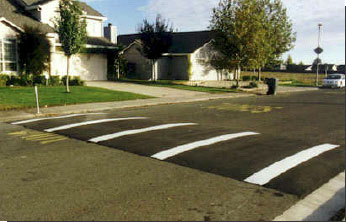Speed humps are rounded raised areas placed across the road. They are generally 12 feet long (in the direction of travel), 3 to 3 ½ inches high, and parabolic in shape, and have a design speed of 15 to 20 mph. They are usually constructed with a taper on each side to allow unimpeded drainage between the hump and curb. When placed on a street with rolled curbs or no curbs, bollards are placed at the ends of the speed hump to discourage vehicles from veering outside of the travel lane to avoid the device. The magnitude of reduction in speed is dependent of the spacing of speed humps between points that require drivers to slow. On average, speed humps achieve a 22% reduction in speeds.

Advantages
- Relatively inexpensive.
- Relatively easy for bicyclists to cross.
- Very effective in slowing travel speeds.
Disadvantages
- Causes a “rough ride” for all drivers, and can discomfort people with certain skeletal disabilities.
- Slows emergency vehicles and buses.
- Aesthetics.
- Signs may be unwelcome by adjacent residents.
